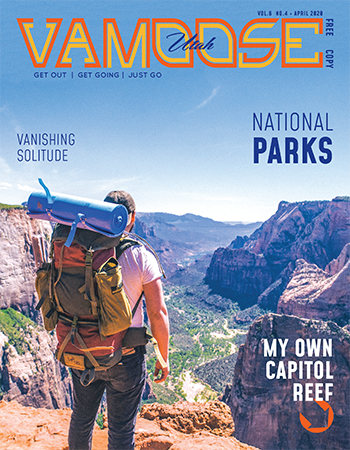A pro-snowboarder embraces the challenge of a life-altering injury.
“Sit on it!” At 40 years old, Tim Ostler is just old enough to remember that classic comeback line from the ’70s TV show Happy Days, never thinking when he watched as a kid, it would apply literally to his own life and happiness some 20 years later.
Ostler, a native of Cottonwood Heights, was in his sixth year as a professional snowboarder in December 2000 when he had a serious halfpipe accident.
“I had been riding earlier that day with some friends in Park City,’” Ostler said, “and had just come home when I received a call that Mervin, one of the companies I rode for, wanted to do a photoshoot there that night. The pipe had been quickly built, lower than normal; conditions and speed also were what caused the fall. I caught the tail coming up and landed badly on my head and legs outside the pipe. I saw it coming and knew it was going to hurt. I really thought I was going to die.”
The crash resulted in a mid-level cervical fracture that sent Ostler to the hospital for nearly three months and ultimately left him paralyzed from the chest down and requiring the use of a wheelchair to get around.
“I freaked out at first,” Ostler remembered of the realization of how his life would be forever changed. “I went from doing a 7-20 underflip to having trouble just picking up a coin. I didn’t really have any depression, though; excitement pretty much outweighed fear. Family and friends were at the hospital every day, as was my girlfriend, Kellie—such an outpouring of love and flowers everywhere!”
As a teenager, Ostler was a rabid skateboarder. He had never been interested in skiing, but snowboarding soon became his passion. His talent landed him sponsors—“A dream line-up,” as he described it—videos, and a sixth-place finish in the Mt. Baker Legendary Banked Slalom.
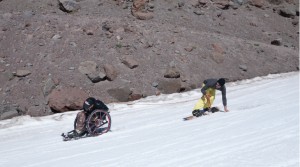 “One of the coolest things that I love about snowboarding are the close friendships,” Ostler said, and it was indeed that fraternity of spirit that provided substantial financial help in his new life. “Two days before the accident,” Ostler continued, “I had gotten my contracts back riding for Quiksilver. When I told them about the accident, they said for me to still sign them and that they would honor them and pay me. Who does that?!” In addition, a host of nationally recognized riders autographed new boards from top manufacturers that were then sold online to help with Ostler’s continuing rehabilitation costs.
“One of the coolest things that I love about snowboarding are the close friendships,” Ostler said, and it was indeed that fraternity of spirit that provided substantial financial help in his new life. “Two days before the accident,” Ostler continued, “I had gotten my contracts back riding for Quiksilver. When I told them about the accident, they said for me to still sign them and that they would honor them and pay me. Who does that?!” In addition, a host of nationally recognized riders autographed new boards from top manufacturers that were then sold online to help with Ostler’s continuing rehabilitation costs.
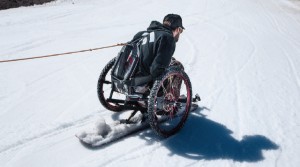 After some time with rehab therapy, Ostler noted real improvement and changes in his physical condition. “It’s still continuing even after 16 years,” he said. “I had been wondering how to get back on a board, and had been doing drawings and online research.” That led to an interest in adaptive skiing, primarily when a friend of Ostler’s at Lib Tech built and paid for a special monoski he called “a narrow-ass snowboard,” Ostler laughed. So, now Ostler truly was going to “sit on it,” learning how to get back on the snow “in this new horizon,” as he put it, and which he still does a few times each ski season at Brighton. “It’s different [from a snowboard], but I like it.”
After some time with rehab therapy, Ostler noted real improvement and changes in his physical condition. “It’s still continuing even after 16 years,” he said. “I had been wondering how to get back on a board, and had been doing drawings and online research.” That led to an interest in adaptive skiing, primarily when a friend of Ostler’s at Lib Tech built and paid for a special monoski he called “a narrow-ass snowboard,” Ostler laughed. So, now Ostler truly was going to “sit on it,” learning how to get back on the snow “in this new horizon,” as he put it, and which he still does a few times each ski season at Brighton. “It’s different [from a snowboard], but I like it.”
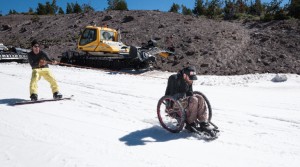
“I ski only at Brighton,” Ostler said, “because I know the mountain and don’t get any surprises. It feels really special since I’m the only monoski up there.”
Ostler maintained his ties to the snowboard industry for 10 years through his work with Backcountry.com as a buyer and which had him traveling to trade shows throughout the year and becoming involved in an interesting collaboration.
“I met Dave Lee of Signal Snowboards,” Ostler said about a show he attended in Long Beach in the fall of 2012, “and he told me that he wanted me to try out one of the concept boards they had developed for their Every Third Thursday web-video series. It was a ‘wheelchair’ board; basically, a snowboard that I would sit on with my feet strapped in that had mountain-bike wheels for the outriggers. I thought it would happen that winter but four weeks later we were at Mt. Hood (site of the U.S. Ski Team training facilities)! I rode the board four times over the two days we were there, and it was unique.”
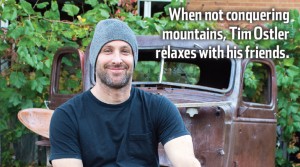 Signal didn’t put the prototype in to production, “but there was a lot of interest around the world from places like Germany and Japan,” Ostler said of his adventure.
Signal didn’t put the prototype in to production, “but there was a lot of interest around the world from places like Germany and Japan,” Ostler said of his adventure.
After leaving Backcountry.com this summer, Ostler now works in sales for Payday, a payroll and insurance company. He and his now-wife, Kellie, are buying a house in Midvale. “I first wondered how I was going to have a life since everything had changed,” he said, “but then I embraced the challenges. I have a real sense of pride in everything I do.”
Ostler also has been involved for 11 years with wheelchair rugby, a Paralympic sport for those with physical impairments/loss of function of at least three limbs. His team, the Salt Lake County Scorpions, travels and competes and is registered with the U.S. Quad Rugby Association (USQRA). It’s a fast-paced, high-action, high-contact team sport that’s both fun to play and watch. The season runs Oct. 14, 2016, through March 31, 2017, and operates out of the Copperview Recreation Center (8446 S. Harrison St., Midvale, 385-468-1515).
In addition, from Feb. 17-19, 2017, the team will host the Wasatch Rumble Rugby Tournament at Taylorsville Rec Center (4948 S. 2700 West, Taylorsville; phone 385-468-1956 for more information).
“I love the sport,” he says. “It’s so worthwhile—even if we lose.”


